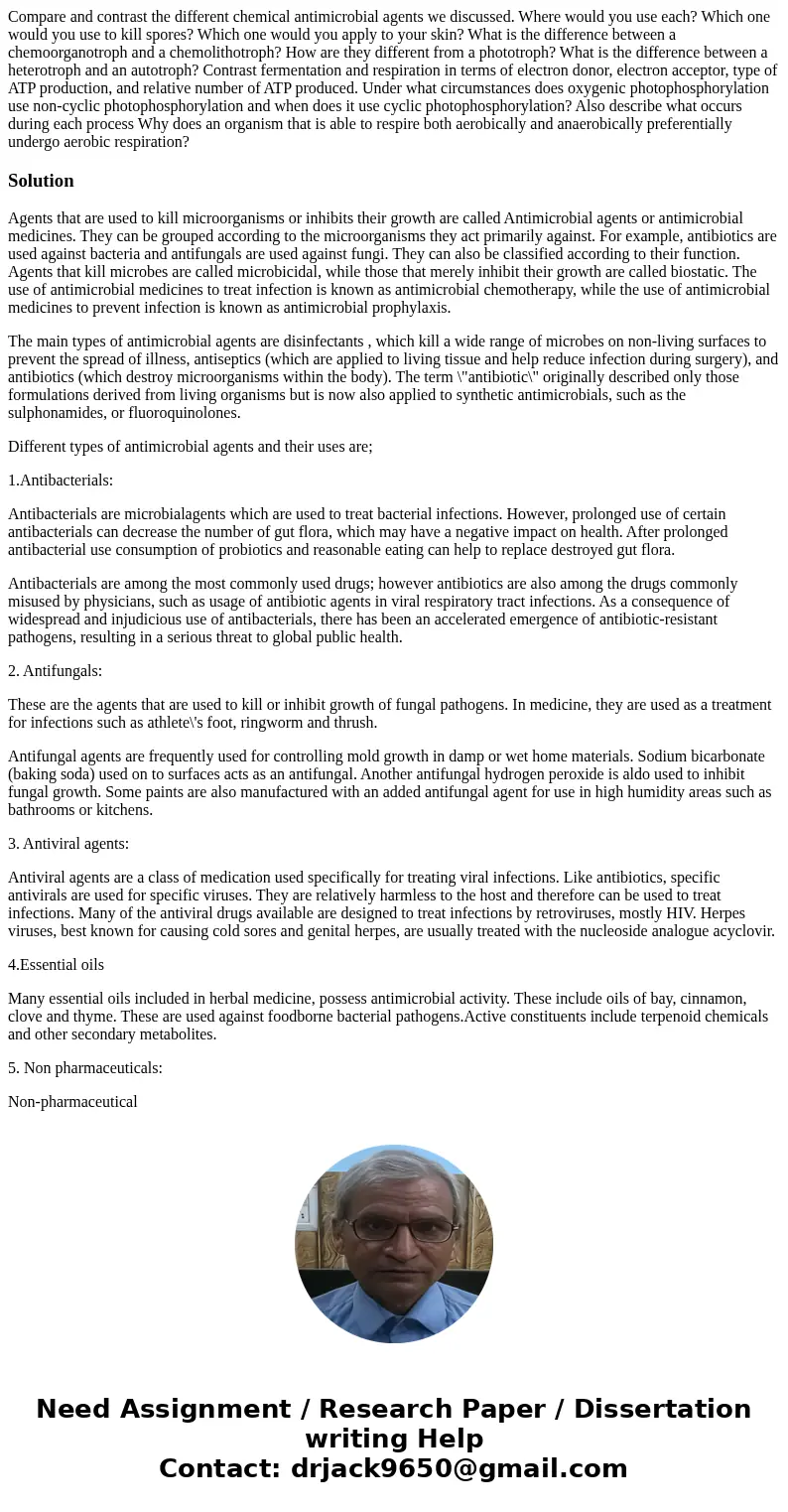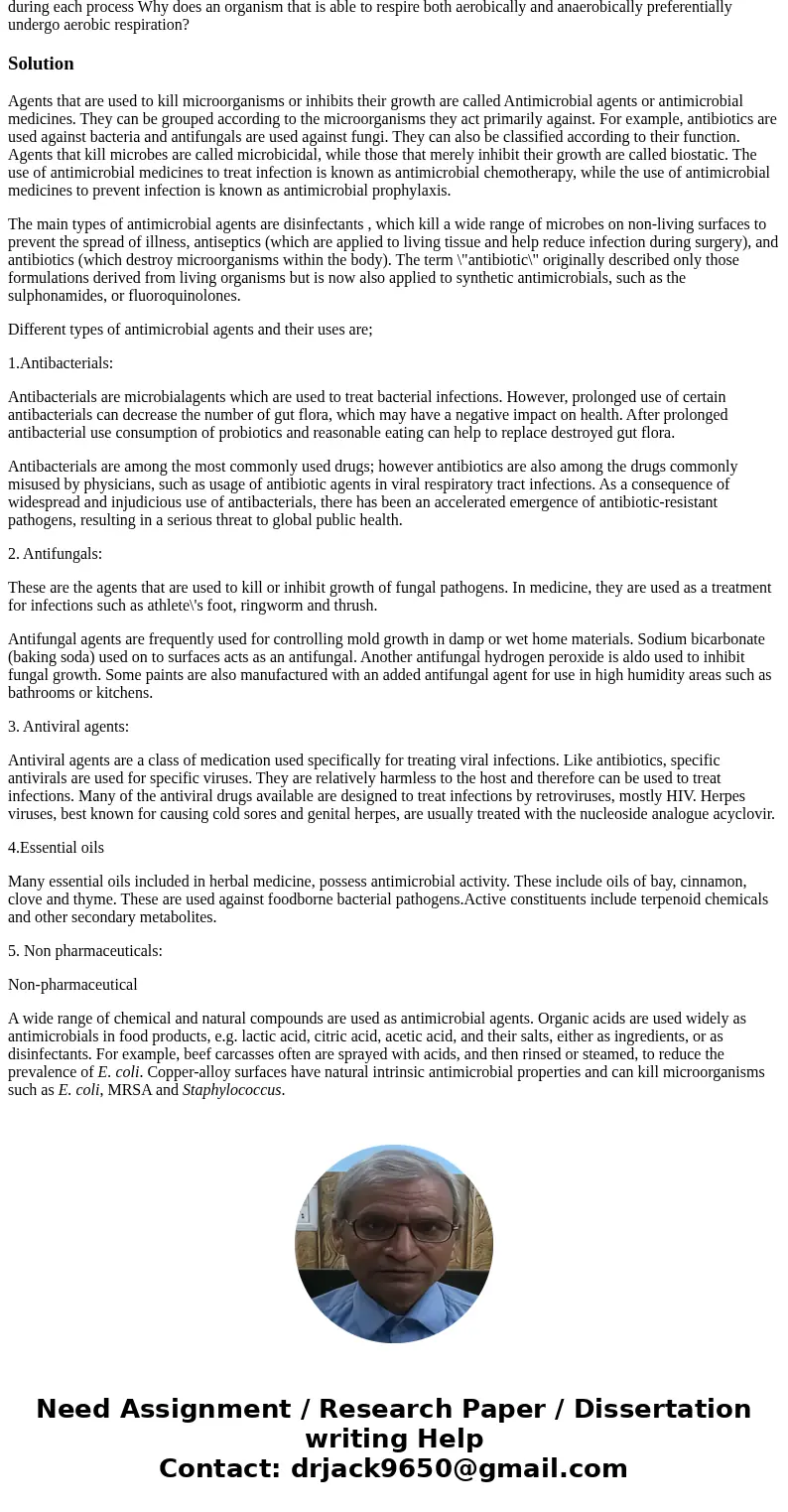Compare and contrast the different chemical antimicrobial ag
Solution
Agents that are used to kill microorganisms or inhibits their growth are called Antimicrobial agents or antimicrobial medicines. They can be grouped according to the microorganisms they act primarily against. For example, antibiotics are used against bacteria and antifungals are used against fungi. They can also be classified according to their function. Agents that kill microbes are called microbicidal, while those that merely inhibit their growth are called biostatic. The use of antimicrobial medicines to treat infection is known as antimicrobial chemotherapy, while the use of antimicrobial medicines to prevent infection is known as antimicrobial prophylaxis.
The main types of antimicrobial agents are disinfectants , which kill a wide range of microbes on non-living surfaces to prevent the spread of illness, antiseptics (which are applied to living tissue and help reduce infection during surgery), and antibiotics (which destroy microorganisms within the body). The term \"antibiotic\" originally described only those formulations derived from living organisms but is now also applied to synthetic antimicrobials, such as the sulphonamides, or fluoroquinolones.
Different types of antimicrobial agents and their uses are;
1.Antibacterials:
Antibacterials are microbialagents which are used to treat bacterial infections. However, prolonged use of certain antibacterials can decrease the number of gut flora, which may have a negative impact on health. After prolonged antibacterial use consumption of probiotics and reasonable eating can help to replace destroyed gut flora.
Antibacterials are among the most commonly used drugs; however antibiotics are also among the drugs commonly misused by physicians, such as usage of antibiotic agents in viral respiratory tract infections. As a consequence of widespread and injudicious use of antibacterials, there has been an accelerated emergence of antibiotic-resistant pathogens, resulting in a serious threat to global public health.
2. Antifungals:
These are the agents that are used to kill or inhibit growth of fungal pathogens. In medicine, they are used as a treatment for infections such as athlete\'s foot, ringworm and thrush.
Antifungal agents are frequently used for controlling mold growth in damp or wet home materials. Sodium bicarbonate (baking soda) used on to surfaces acts as an antifungal. Another antifungal hydrogen peroxide is aldo used to inhibit fungal growth. Some paints are also manufactured with an added antifungal agent for use in high humidity areas such as bathrooms or kitchens.
3. Antiviral agents:
Antiviral agents are a class of medication used specifically for treating viral infections. Like antibiotics, specific antivirals are used for specific viruses. They are relatively harmless to the host and therefore can be used to treat infections. Many of the antiviral drugs available are designed to treat infections by retroviruses, mostly HIV. Herpes viruses, best known for causing cold sores and genital herpes, are usually treated with the nucleoside analogue acyclovir.
4.Essential oils
Many essential oils included in herbal medicine, possess antimicrobial activity. These include oils of bay, cinnamon, clove and thyme. These are used against foodborne bacterial pathogens.Active constituents include terpenoid chemicals and other secondary metabolites.
5. Non pharmaceuticals:
Non-pharmaceutical
A wide range of chemical and natural compounds are used as antimicrobial agents. Organic acids are used widely as antimicrobials in food products, e.g. lactic acid, citric acid, acetic acid, and their salts, either as ingredients, or as disinfectants. For example, beef carcasses often are sprayed with acids, and then rinsed or steamed, to reduce the prevalence of E. coli. Copper-alloy surfaces have natural intrinsic antimicrobial properties and can kill microorganisms such as E. coli, MRSA and Staphylococcus.


 Homework Sourse
Homework Sourse